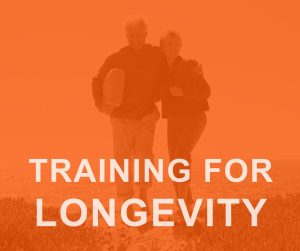Of the many varied, personal, functional, and subjective goals that our personal training clients strive for, we generally hear “strength”, “fat loss”, or “performance”. But of equal importance to our community and practice is “longevity”. With our aging population and an increase in older personal training clients, it can be important to focus sessions, classes, and programming on maintaining functional health and fitness for many years to come.
Exercise and Longevity
One of the common threads between all of the changing fads and protocols in fitness since, well, the beginning of fitness, is that they all work for someone. Different goals might require different approaches and styles. Often, new programming arises as simply an answer to our human need for novelty. But if our objective is to maintain health and fitness for as long as possible, there are a few reliable tips we can follow.
Low impact exercise will help us to maintain joint integrity and reduce the instances of injury from exercise. HILIT (High-Intensity Low Impact Training) for instance is a valuable method for creating a workout that is effective, helps clients feel successful, and provides a low-impact workout that spares joint stress. Although the benefits of High-Intensity Intervals and sprint intervals are great, HILIT mixed with some steady-state cardio can be valuable for those with the goal of longevity. A vigorous walk, with even a slight elevation in heart rate, will suffice.
Dr. Valter Longo, in his book The Longevity Diet, suggests what most fitness professionals abide by already; using your muscles is good. Weight-bearing exercises that utilize all of the muscle groups on a regular basis is ideal. Whether that effort is achieved through Pilates or Yoga, hiking and climbing, classic weight lifting or any other method doesn’t seem to matter.
Lifestyle and Longevity
The way we exercise is important for maintaining skeletal function and metabolic health among other things. But food, family, and purpose are major factors in longevity as well. In her book Healthy Dividends, Tricia Silverman writes “Finding a sense of purpose is often an overlooked element of overall health. One reason for this connection with health may be that when we have a purpose, we’re more likely to take care of ourselves..”
The popular Blue Zones theory, that suggests certain populations that have “super-agers” exist because of a combination of diet, physical activity, and purposeful living, express the same sentiment at Silverman does in her book. The theory suggests that tight-knit communities, like those that can be found in a church or religious group, can provide many beneficial health outcomes. Multi-generational living, such as grandparents living with children and grandchildren, also seems to provide a certain amount of purpose and longevity in these blue zone communities.
Although nutrition can vary between individuals and communities, a moderate caloric intake of vegetables, legumes, and nuts, with even more moderate amounts of meat are recommended by a number of sources. Proper amounts of sleep and mental stimulation also seem to account for long, healthy lives.
Quality Not Quantity
To end this article with another quote “Life is not measured by the number of breaths we take, but by the moments that take our breath away”… pretty sure that one was Maya Angelou. In other words, the length of life might not be as valuable as the experiences in life. That being said, life will probably be experienced better when we are in better health. So our training protocol should always strive to keep us as healthy and fit as possible, but should also reflect our goals and help us do the things we like to do, better.
Andrew Gavigan is a recognized speaker in the fitness industry, master trainer, Creator of the mostFit Core Hammer, and serves as Director of Education for Aktiv Solutions. He is a NASM and NFPT Certified Personal Trainer and Behavioral Change Specialist and has developed comprehensive fitness and exercise programs for health club & workplace wellness facilities. Andrew’s passion centers around user engagement and human behavior.


